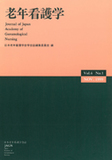Japanese
English
- 販売していません
- Abstract 文献概要
- 参考文献 Reference
本研究の目的は,急性期の内科治療を受けるために入院した高齢者のせん妄がどのような状況で発症するか,その発症過程と発症因子を明らかにすることである.急性期状況にある高齢者は,環境の変化に対する適応力が乏しいという特徴がある.そこで,Royの看護適応モデルを基盤に本研究の概念モデルを作成し,データ収集を行った.
対象は,さまざまな疾患で内科治療を受けるために入院した44名である.せん妄は44名中8名(18%)に発症し,発症時期は全員,入院当日から3日目までの期間であった.初発症状の出現からせん妄が完成するまでの時間経過は,3つのパターンに分類できた.せん妄発症後,症状が消失するまでの終息過程もまた,3つのパターンに分類できた.せん妄発症にかかわる因子の分析で有意差(p<.05)が認められたのは,安静療法,ライン類の本数,ヘモグロビン値,脈拍数,口渇,ADL得点,不安反応,頑固・短気な性格の8因子であった.
急性期の内科治療を受ける高齢者のせん妄のアセスメントは,入院・治療に伴うせん妄の発症因子だけでなく,それらのストレス因子を高齢者がどのように捉え,反応しているかという点に着目することの重要性が示唆された.
The purpose of this research was to identify the risk factors that contribute to the development of delirium among elderly patients in an acute medical setting. Elderly patients in an acute setting have difficulty with environment adaptation. The conceptual framework for this study was based on Roy's Adaptation Model.
The subjects were 44 patients with various medical diagnosis admitted to an acute medical unit.
Delirium occurred in 8 of the 44 patients (18%) within three days of hospitalization. The process of the development of delirium was classified into three patterns. Also the process of recovery from delirium was classified into three patterns. The risk factors which were significant (p<.05) were : bed rest, number of tubes, hemoglobin value, pulse rate, dry tongue, activities of daily living score, level of anxiety, stubborn or passionate patient personality.
This study suggests the importance of nursing assessment of the risk factors for delirium. This assessment will enable nurses to identify patients may have a maladaptive response to acute care hospitalization.
Copyright © 1999, Japan Academy of Gerontological Nursing All rights reserved.


